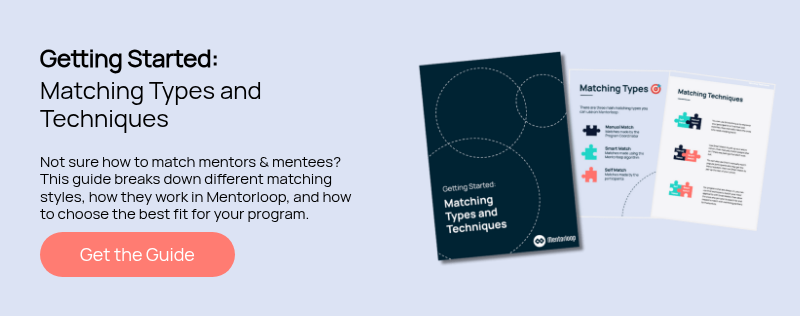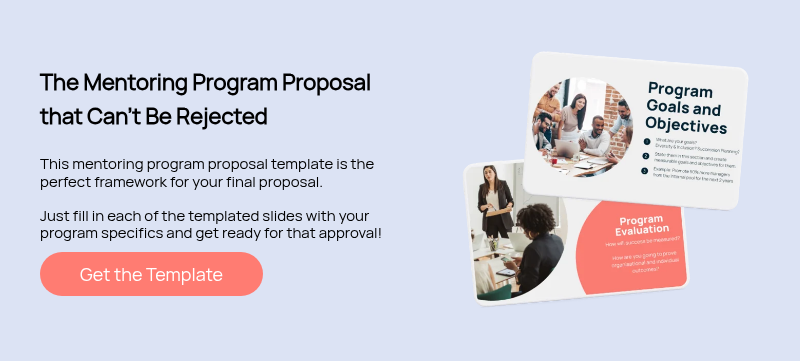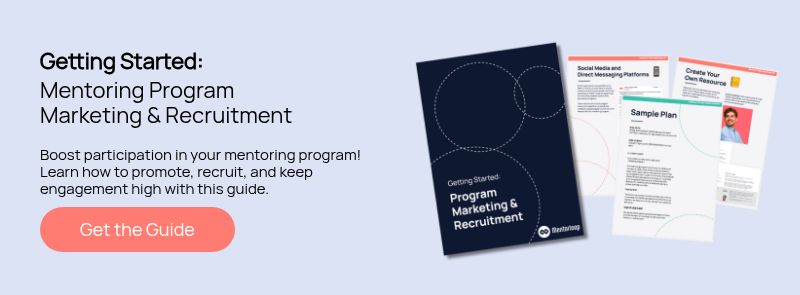If you’re considering setting up a mentoring program in your organization, you’re on the right track. Mentoring programs are invaluable tools that can help everyone gain new skills, develop their careers, and expand their networks. And because it’s so impactful, there’s pressure on program coordinators everywhere to get it right. We know creating a successful mentoring program requires careful planning and execution. So in this article, we’ll guide you through the essential steps to set up a mentoring program that is effective, not just for your mentors and mentees, but for program coordinators as well.
Let’s get to it.
Step 1: Define the “Why” of Your Program
Before you start setting up your mentoring program, you need to define its purpose. What are you hoping to achieve with this initiative? Are you looking to improve employee retention, accelerate career development, or enhance leadership skills? Or are you an industry association looking to increase member retention and add value to paid memberships? Do you want to facilitate learning and development or create leadership opportunities for those who would normally miss out?
Whatever your goals are, make sure they’re clearly defined and communicated to all stakeholders. This will help you to make sure that your program aligns with your organization’s broader mission and that everyone understands the benefits of participating. It will also help you work out who you need to target as participants and how you’ll match them.
For instance, if your organization is looking to improve employee retention, you might want to focus on pairing more experienced employees with newer ones. This can help new employees feel more connected to the organization and reduce turnover. On the other hand, if you’re hoping to enhance leadership skills among your association members, you might want to focus on pairing mid-level managers with senior executives to help them develop the skills they need to take on more senior roles.
Essentially, your goals will set up the foundation for all the other details of your mentoring program. By defining the “why” of your mentoring program, you also align expectations for all parties involved and provide clarity in program design and implementation. This will help ensure that the program is effective and meets the needs of the larger organization, the individual/s running it, as well as the participants. This is why this first step is absolutely crucial to tick off before you do anything else.
Step 2: Decide How You Will Measure Success
Next, you’ll need to decide how to measure success. Do you need to take any current measurements to use as a program benchmark? Having a clearly defined “why” will guide what success metrics you need to be tracking to understand how you’re tracking towards your goals as your program runs. Whatever metrics you choose, make sure they’re clear and that you have a plan for collecting and evaluating this data. By defining measurable outcomes, you’ll be able to assess the success of your mentoring program and make necessary adjustments for the future.
For example, if you’re hoping to improve employee retention, you might want to track the retention rate of employees who have participated in the program compared to those who haven’t. If you’re hoping to enhance leadership skills, you might want to track the number of program participants who have been promoted to more senior roles within the organization.
If you’re wanting to positively impact career development through your mentoring program, you can track the career progression of participants over time. This could include tracking promotions, salary increases, and job changes. By comparing the career progression of those who participated in the mentoring program to those who did not, you can determine the impact of the program on career development.
Additionally, it’s important to consider the qualitative benefits of a mentoring program. Mentoring can help to build a sense of community within your organization, foster relationships between individuals, and promote a culture of learning and development. These benefits may be more difficult to measure, but they can significantly impact your organisation’s overall success.
Pro Tip: Measuring the qualitative benefits of your mentoring program is easy with Mentorloop. With robust analytics and reporting tools that are built for sharing, you can easily monitor your mentoring program’s health and share it with your stakeholders. This allows you to focus on measuring metrics for your larger goals without having to spend too much time and effort on making sure your mentoring program is healthy.
If you’re keen to learn how Mentorloop does this, watch this video:
Step 3: Get Leadership Buy-In
One of the keys to a successful mentoring program is having buy-in from senior leadership. If your executives are supportive of the initiative, it’s much more likely to be successful. It’s important to do this in the early stages. This way you can build the program plan with their input and they can feel involved in its development.
Talk to your leaders about the benefits of mentoring, and how it can improve skills, engagement, and retention. Also, make sure they understand that there is an ROI to a mentoring program – that it’s not just a nice-to-have. Chances are, your leaders have had mentors in their careers and/or have mentored others and know the value of mentoring. They just need to know that there’s a return on the time and resource investment that will be dedicated to a formal program.
You can even start getting them interested in participating in the program as mentors themselves. This can help to show their support for the initiative and encourage other employees to participate once you launch.
It’s also important to communicate to your leaders that you’re not just after their approval for your program and its budget – you’re also after their input and involvement. Ask for their thoughts and what they can do to help. Allow them to feel some ownership over the mentoring program. Make sure they know that this program is not a short-term activity either. Rather, communicate that it’s a step towards creating a culture of mentorship within the organization. And to achieve that, their involvement and influence is key.
Allow them to share their potential concerns or objections with you and be prepared to address them. And you don’t have to address them immediately either. Don’t be afraid to go away and come back with a plan – it shows that you value their concerns and are willing to work on a plan to mitigate or resolve them.
Ultimately, getting leadership buy-in is about building relationships and demonstrating the value of the program. By showing how the program can benefit both the organization and its people, you create a strong case for why your leaders should support it and get involved.
Learn more about how to get leadership support for your mentoring program in this blog post:
Step 4: Engage Your Stakeholders
This step is probably more important for larger organizations. Getting support and engagement from all levels and departments is key, especially if your program will be open to the whole organization.
All organisations are different, but for some, you’ll need to engage your IT and procurement teams’ help. Your marketing and/or communications teams might also need to be involved when the time comes to recruit for your program.
Pro Tip: If you’re working with Mentorloop, engaging your IT and procurement teams, and even your legal team, to help with implementation is easy! They love us because we’re fully compliant with GDPR, Cyber Essentials Certified, and registered with the ICO. Mentorloop also does Single Sign-On and Social Sign-On and integrate with everything you already use like your HRIS and CRM, communications apps, and scheduling tools.
Getting key people in several areas of the organization involved early and communicating the mentoring program’s purpose and benefits to them will make launching and running the program easier in the long run. This will help ensure that everyone involved is on the same page and working towards the same goals. And much like with your leaders, this also gives them a sense of ownership and involvement with your mentoring program, increasing the likelihood of a good turnout and high engagement.
By engaging all stakeholders and communicating early and clearly, you can establish a good support system for your mentoring program early and set up a mentoring program that truly delivers results and helps drive growth and development for everyone involved.
Step 5: Decide How You'll Match Participants
Matching mentors and mentees is a crucial step in the mentoring process. So when you set up your mentoring program, it’s important to ensure you’ve got your matching method and criteria down as this can make or break the success of mentoring relationships. So, decide how you’ll match your mentors and mentees during the planning process. Go back to your program’s goals and also consider the kind of organization you’re in when deciding this. These will help you determine what matching criteria and matching type will work best for your mentoring program.
Create Your Matching Criteria
Refer back to the “why” of your program and the metrics you’ve put in place to measure success. What information do we need to achieve our desired outcomes, and create the optimum participant experience? If you’re unsure how to tackle this, here are a few questions you can work with to get you started.
Consider How You Will Match
Do you want to retain control of the matching, or empower your team to self-select their own mentor? Or do you want to do a little bit of both? The quality of the match is what inevitably drives the quality of outcomes. So, thinking about the best matching methodology based on your program objectives is important. Alternatively, you can leave it to the experts (like us here at Mentorloop 😉) to match your participants with our equitable matching algorithm based on input from hundreds of successful mentoring programs that we’ve helped run.
Let’s quickly run through the three types of matching.
Manual Match
Manual matching is coordinator-led matching where the program coordinator manually chooses matches for the entire cohort and connects mentoring pairs with each other. On Mentorloop, program coordinators can view potential matches in a cohort, along with all their matching criteria so you can make the best matches possible.
This is great for smaller programs where the program coordinator has knowledge of the people involved. This is also good for highly curated or targeted programs.
Self Match
This option allows you to empower your participants to organise themselves into their own matches. On Mentorloop, participants can choose a mentoring partner by browsing through participants and requesting and accepting match requests based on anything that appears on their profile.
This is great for larger programs and program coordinators who don’t have the time for manually matching an entire cohort.
Smart Match
A matching algorithm (we call it Smart Match at Mentorloop) is the way to go for large cohorts as it allows program coordinators to match a whole cohort in minutes based on matching criteria that you set.
Mentorloop’s equitable matching algorithm, which is available on Mentorloop Enterprise, ensures all of your participants get high-quality matches. Where other mentoring software algorithms prioritise higher compatibility for a few, Mentorloop prioritises good pairings for all – no one gets left behind.
Step 6: Scope Out The Resources You'll Need
As you set up your mentoring program, it’s important to consider the resources you’ll need to make it a success. This ensures you actually have all the resources you need to run it before launching your mentoring program. This includes the personnel needed to manage the program, a budget, and the technology to support it.
- Program Coordinator/s: Who is going to run your program? Do you need one person or do you need two? A small team?
- Budget: Do you need a budget allocated for a launch event or a marketing campaign? What about some face-to-face learning sessions or networking events? Training materials?
- Technology: While smaller programs may not need it, we find that most mentoring programs do need mentoring software to effectively and efficiently set up and run a mentoring program and measure mentoring success. It just makes everything, from program set-up, participant management, matching, feedback collection, reporting, and scaling, so much easier and less time-consuming for mentoring program coordinators.
Step 7: Brush Up On Best Practices
As with any endeavour, it’s recommended to brush up on mentoring program best practices before launching one. Doing this could inform some decisions and plans you make, and overall just gives you a better chance for success. Understanding what has worked for many others will help you design a mentoring program that has a higher chance of achieving its goals and having great participant satisfaction.
Launching a mentoring program without considering best practices can increase the risk of challenges, conflicts, or negative experiences for participants. By studying best practices, you can identify potential risks and develop strategies to mitigate them in advance. This proactive approach helps create a better and more positive environment for all participants involved. It also means an easier time managing the program for you.
Remember that best practices are not static; they evolve with changing needs, research, and societal expectations. Brushing up on best practices allows you to stay updated with the latest insights and innovations in mentoring programs. This enables you to continuously improve your program by incorporating new ideas, addressing emerging challenges, and adapting to evolving trends.
Pro Tip: If you’re running your program on Mentorloop Enterprise, our team of Mentoring Specialists keep you up to date on these best practices and guide you and your program on the road to mentoring success. With regular strategy sessions with mentoring experts, you can be assured that you always have access to the best mentoring knowledge and are supported in implementing best practices in your meeting program.
Familiarizing yourself with best practices before launching ensures that you benefit from the collective wisdom and experience of others. It increases the likelihood of program success, improves participant satisfaction, minimizes risks, and enables continuous improvement.
This also demonstrates professionalism and a commitment to excellence – important for when you make your pitch to your organization’s leaders. It shows that you’ve taken the time to research and incorporate best practices into the set-up of your mentoring program which can build trust and credibility with stakeholders, leadership, donors, or sponsors.
Step 8: Make Your Pitch
Now it’s time to put together your final proposal and pitch your mentoring program to your stakeholders. Highlight the general benefits of the mentoring program, its goals, and why you’ve set up this mentoring program.
Make sure you’ve got an iron-clad mentoring proposal ready. Don’t forget sprinkle in some anecdotes from your mentoring champions to make it even more compelling than it already is.
So, get to work on building your proposal and your presentation, then get ready to present it.
Shoulders back, head high, and nail that pitch! 💪🏽
Step 9: Market Your Mentoring Program
Once you’ve got the green light, it’s time to get your marketing hat on!
Have a strategy in place. It can be as simple or as complex as you want. The important thing is that you’re targeting the right people and have the right messaging in place before you start your recruitment drive. Go back to your program’s goals and why you’re launching this program to determine this.
There are many assets available to you that you can take advantage of for marketing and recruitment for your mentoring program. You can use emails, your website or intranet, social media, common spaces in your offices, etc. You can also hold meetings and targeted recruitment webinars, or go all-in and hold a big event to kick off your recruitment drive. It’s all up to what you think your program needs, what your target audience will respond to, and the time and resources available to you.
Watch this video for some tips on how to market your mentoring program using assets you already have.
Step 10: Launch Your Mentoring Program
Finally, after all the preparation, it’s time to implement the mentoring program you’ve worked hard to set up. This is the fun part!
Remember to choose a method that you think your organisation and your people will respond well to. Is there a really visible area in the office that people look to for news or resources? Is your intranet heavily used? Does your team rely heavily on communication apps rather than use email? Take all of these into account when choosing your launch method.
For industry associations that have members in different places and organisations, a launch announcement on the website and an association-wide email might be best, plus maybe an announcement at one of your regular events. Big corporates might go a different way. A big launch event, a directive for managers to use their next team meetings to encourage their teams to join, a big announcement on the company intranet, and a company-wide email from the CEO and the Program Coordinator might be the way to go.
Whatever method you choose, make sure you cover the basics:
- The “why” and the goals of your mentoring program
- Where mentors and mentees can sign up
- Links to more information about the program and what’s expected of participants
Additionally, if you have a list of participants you’d like to invite to your program, you can simply upload a CSV file of this list via Mentorloop’s bulk invite feature and let it send the invitations for you!
In Conclusion
Setting up an effective mentoring program requires careful planning and execution. But if you follow these steps, you’ll be well on your way to being the most well-prepared program coordinator you can be. And if you want to smoothly and effectively run your best mentoring program yet with Mentorloop, you can get started today or book a demo with one of our mentoring experts!
Good luck!






![[Webinar Kit] Launching Strong: A Guide to Your Mentoring Program's Critical First Weeks Learn how to follow through from a successful launch and set your program up for long-term success.](https://no-cache.hubspot.com/cta/default/4058869/interactive-190071553324.png)


